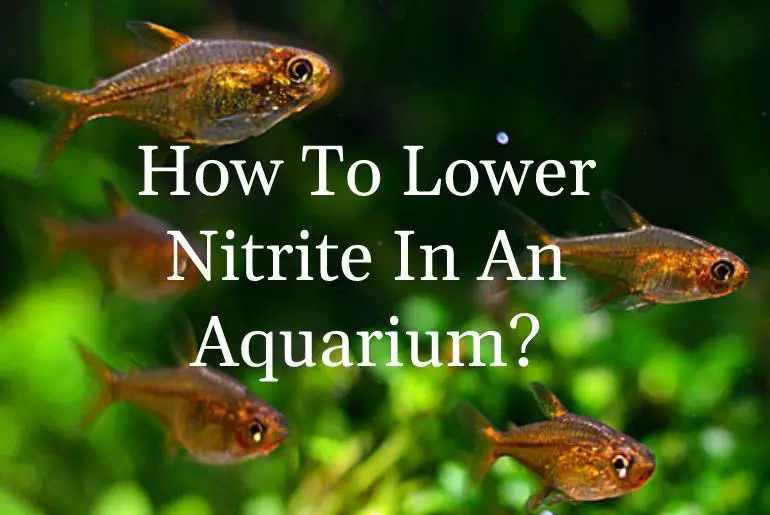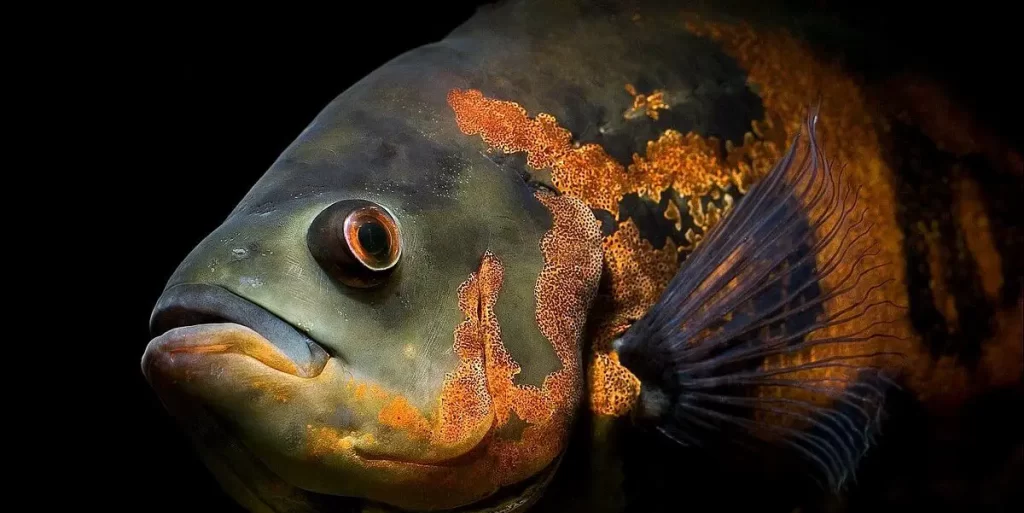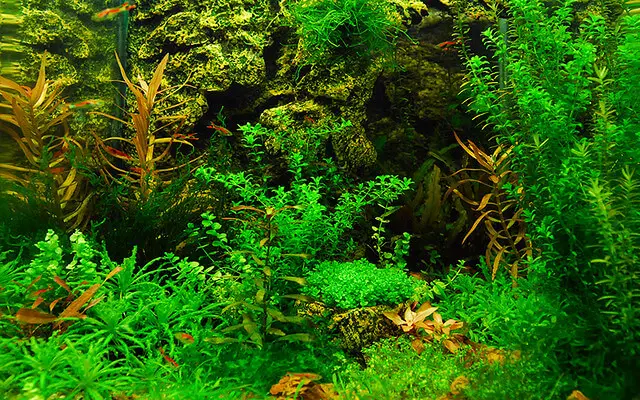Nitrites in the aquarium are something no one will want, neither us nor your fish. Trust me; your fish hates having nitrite in the tank as it hampers their health and longevity. If you see nitrite level spiking up in the tank even when you have brought ammonia level in check, you have more tasks to do, my friend. Nitrite intoxication is equally hazardous as ammonia poisoning. But how to lower nitrite in an aquarium?
Well, the process is quite simple when it comes to lowering the nitrite level in an aquarium. Water change, Cycled filters, and a water conditioner will cover up for you and lower the nitrite level in the aquarium.
However, avoiding overstocking and overfeeding your fish while cleaning and filtering your tank water often will solve this problem before it occurs.
I know this will not suffice for you to lower the nitrite level, and want more detailed information.
So, I have written a whole article below for you to learn more about nitrite intoxication, its consequences, how to lower it, etc.
Let’s dive in!
How To Lower Nitrite In An Aquarium?
Okay, you might get worried like hell when you see the nitrite level peaking up. Don’t worry, calm yourself down first and follow my instructions carefully.
There are few things, actually, that you can do to lower the nitrite in an aquarium. Or else you will find dead fish floating in the tank.
Okay, sorry, not scaring you just sating the fact here. Here is what you need to do.
Water Change
First thing first, change 40 to 50 percent of aquarium water immediately with clean water with no nitrite or ammonia.
This will dilute the nitrite presence in the tank and hence let the beneficial bacteria do their work after that.
You must change the water often but do not overdo it. Excessive change of aquarium water can also affect your fish and aquarium ecology.
Completing Aquarium Nitrogen Cycle
Sometimes malfunctioning of filter or the absence of beneficial bacteria in the filter media becomes the prime cause for the high level of nitrite in the tank.
Once the nitrifying bacteria present in the biological filter media colonize properly, you will barely face nitrite poisoning in the tank.
So, whenever you see nitrite levels going up, check the state and condition of your filter media as well as beneficial bacteria.
Both nitrifying bacteria are equally important in the tank. Hence, make sure both ammonia to nitrite converting and nitrite to nitrate converting bacteria are present in the biological filter media.
Once, these aquarium beneficial bacteria perform and complete the aquarium nitrogen cycle, the nitrite level will lower automatically.
Get A Water Conditioner
Sometimes, the most efficient way is the most instant way. Basically, you need to get a water conditioner, a nitrite remover, from a store and mix it in the aquarium water.
These conditioners will bind themselves with nitrite and make it harmless to fish. They will not only detoxify the aquarium water but also make the water quality optimum.
But remember, these removers are merely removing the nitrite but not solving the problems that are producing nitrite in the first place.
Seachem Prime Fresh and Saltwater Conditioner – Chemical Remover and Detoxifier will help you in this step.
Use Filter With Full-Colonized Beneficial Bacteria
The new filter takes time to colonize nitrifying bacteria in the biological filter media so they won’t be able to convert ammonia into nitrite and then finally into nitrate.
Hence, you need to use the cycled filter that has well-developed beneficial bacteria colonies.
These aquarium beneficial bacteria will convert nitrite into nitrate during the filtration process.
The level will go down to zero in no time when you use an old cycled filter. Thanks to the high number of beneficial bacteria.
What Happens If You Don’t Lower The Nitrite In An Aquarium?
As I have been saying from the very beginning, nitrite is harmful to fish. But you won’t believe me until I tell you the reason why.
So, here I will let you know the consequences when the aquarium has a high level of nitrite. If you don’t put effort into lowering the nitrite, you might lose the fish in the aquarium soon.
Nitrite Intoxication
When the nitrite level rises up, the aquarium will start to get toxic for the fish due to nitrite intoxication or nitrite poisoning.
This will invite a horrible death for your fish and trust me it will be quite painful for you to watch your fish die like that.
Suffocation
The increment in the nitrite level or nitrite poisoning suffocates the fish no matter the level of oxygen in the tank.
You might like to read more about How To Maintain The Oxygen Level In Aquarium?
Even the air pump or surface agitation cannot stop the suffocation in fish until and unless you lower the nitrite level in the aquarium.
They will start to gasp for breath and die after struggling for a while. Sorry to say, but you will be the one to be blamed for its death.
Stress And Disease
The toxicity of nitrite affects freshwater fish more than saltwater fish due to the presence of chloride in the saltwater.
You might be interested to learn about How to Lower the pH Level In Saltwater Aquarium?
However, most freshwater fish will start to get stress and die even with the faintest hint of nitrite in the tank.
Some fish can be quite tolerant to the nitrite level, while some will meet death when the nitrite level reaches 0.29 ppm.
The stress in the fish due to nitrite increment will invite various diseases and hence deteriorate the fish health more.
Color Fading
The color of your fish will start to fade when their body is exposed to a high level of nitrite for long period.
This color fading will soon develop into skin disease, making you sicker and sicker every day.
Sterilization
The reproduction capacity of the fish will decrease and get to the minimum or zero when they are exposed to nitrite for a certain interval.
Underdeveloped Growth
The growth rate and the development of organs in fish are highly hampered by the presence of nitrite in the tank.
What Nitrite Levels Are Acceptable In An Aquarium?
Well, Zero is the number that needs to come on the test kit when you test your aquarium water for nitrite. API NITRITE TEST KIT will help you to test water more effectively and faster.
Nitrite is harmful to fish even if it is less in number. You can’t risk leveling up the nitrite in the well-established tank.
Or else you will find suffocating, sick, gasping, and dying fish in your tank. However, when the tank is new and yet to be cycled with the filter with biological media along with beneficial bacteria, nitrite levels can be high.
So, that’s why I suggest you to put the fish in the new tank after the tank is well-cycled and beneficial bacteria is well-colonized.
If you find a nitrite level higher than zero, find the cause and reason behind it immediately. And Solve the problem as fast as you can.
What Causes High Nitrite Levels In An Aquarium?
Carelessness and overlooking problems of the tank are what will invite the ammonia and in turn nitrite into the tank.
You need to know the culprits behind building up the nitrite and ammonia in the tank. Sometimes the nitrite level increases to the level toxic for your fish.
The causative agents of high nitrite level to the extent of making effort to lower it are down below:
Overfeeding Your Fish
Overfeeding your fish can bring so many consequences on fish and fish tanks that you have no idea. The excessive amount of food intake means a high amount of excretion from fish.
Fish excretes are the number one reason for the increment of ammonia in the tank. An increment in ammonia means an increment in nitrite level.
You need to understand that the leftover food will also spike up the nitrite level. Overfeeding is the curse for both fish tanks and fish.
Overstocking Your Tank
When there are a huge number of living beings present in a small space, the waste product density increases without question.
When you keep fish more than the tank can accommodate and produces more waste products than your filter can filtrate out, you are in trouble, my friend.
The ammonia level will skyrocket due to the high build-up of waste materials and hence you have to deal with nitrite intoxication as well.
Absence Of Aquarium Beneficial Bacteria
Aquarium beneficial bacteria are nitrifying bacteria that turn ammonia and nitrite into essential nitrate through the aquarium nitrogen cycle.
But in absence of these bacteria, aquarium ammonia poisoning and nitrite intoxication will occur. This will kill your fish and trust me the death will be a very painful one.
Weak Filtration
When the aquarium filtration methods or the system starts to fail, the pollutants will not be filtered out of the tank.
Hence, these waste products will accumulate in the tank, forming ammonia and nitrite. The filtration system is the best way to overcome aquarium ammonia poisoning and nitrite intoxication.
And when the aquarium filter starts to malfunction or stops, the nitrite level spikes up to level toxic for the fish.
Excessive Solid Waste
When the leaves wilt from the aquatic plants or the fish dies in the tank, these things will start to pollute the water.
If you don’t remove them, these pollutants will start to decay and produce ammonia in the tank.
Spiking up ammonia results in the increment of nitrite level almost immediately. Hence the consequences in fish and fish tanks.
Preventive Measures To Keep The Nitrite Level Optimum
“Prevention is better than cure” should be your motto in life while raising a fish in captivity.
The fishkeeping hobby isn’t as easy as it looks from afar. The grass is always greener on the other side.
So, understand the work you need to put into fishkeeping before acquiring this hobby. Sometimes, some problems in fish will turn irreversible, and I know you won’t like that.
The same thing is with the nitrite level in an aquarium. You need to prevent the building up of nitrite level rather than taking measures to lower it.
- Stop overfeeding your fish. Learn more about Fish Food 101: A Beginner’s Guide On How To Feed Aquarium Fish.
- Remove the excess uneaten food immediately from the tank.
- Clean the water more often. Learn more about Why Do Fish Tanks Get Dirty So Fast – How To Clean And Maintain Tanks
- Install biological filter media with aquarium beneficial bacteria in the filter.
- Change 25 to 40 percent of the water every week. Learn more about How To Perform Aquarium Change Safely?
- Clean the filter too once in a while.
- Do not overstock your fish tank.
- Maintain the plants and remove the dead leaves as soon as possible. You might like to read about The Easiest Way to Clean and Maintain Aquarium.
Frequently Asked Questions
I know more questions are lingering behind your head about nitrite intoxication. So, I have tried to answer a few of them for you.
Will Nitrates Lower On Their Own?
Yes, Nitrate will lower when the aquarium cycle comes to an end. But the slightest amount of it will always be there.
Do not think nitrate can’t harm your fish because it does. You need to make sure the nitrate level is on the check as well and take help from plants to lower the nitrate level in the tank.
What Is More Toxic Ammonia Or Nitrite?
Ammonia is more toxic when you compare it to both nitrite and nitrate. This happens when the temperature is higher and the pH level is above towards basic side.
Here is an article on How to Adjust pH in Fish Tank – Fishkeeping Guide.
Ammonia poisoning can instantly kill your fish while nitrite intoxication gives you a warning and chance to save your fish.
Conclusion
In a nutshell, nitrite building up in the aquarium will bring death to your dear fish. So, keep testing the water often, even when the ammonia level is zero. Sometimes a small mistake will bring disaster to your fish tank. I know you don’t want your fish to get sick or die. So, make sure you feed your fish appropriately and filter the water more often.
Just follow my lead precisely, and you will be a great aquarist after a while.
Good luck!!
Happy Fishkeeping!!!






